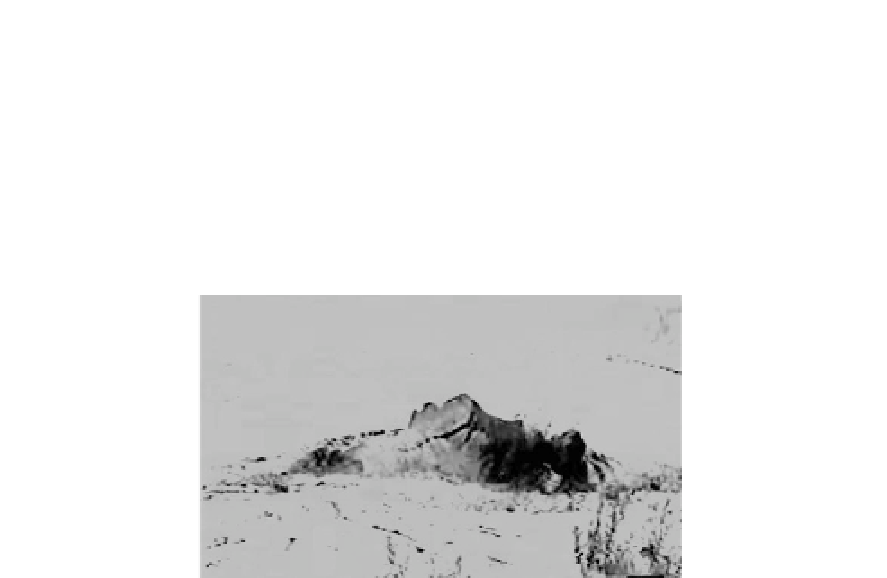Environmental Engineering Reference
In-Depth Information
witnesses as follows: as the flood passed, a block of the river bed, about one meter thick, was torn off by
the flow; it turned around and stood up, towering over the water surface for several seconds. Then it
collapsed with a great noise. After several minutes another block of the riverbed towered over the water
surface and collapsed again. Such a fantastic phenomenon usually causes very quick erosion of the
channel bed and has been recorded at Longmen and Tongguan on the middle reaches of the Yellow River,
Lingtong on the Weihe River, and once on the lower reaches of the Yellow River upstream from
Huayuankou. The phenomenon occurred at Longmen again during a hyperconcentrated flood in 2002, as
shown in Fig. 5.36.
Fig. 5.36
“Ripping up the bottom” occurred near Longmen on the Yellow River during a hyperconcentrated flood
in 2002
A hyperconcentrated flood may scour the channel bed down by several meters or even more than ten
meters, in the form of “ripping up the bottom” or normal erosion. Figure 5.37 (a) shows the discharge,
sediment concentration, stage, average elevation of the channel bed, and elevation of the deepest point of
the channel measured at the Longmen station during a hyperconcentrated flood from August 1 to August
4, 1970; and Figure 5.37(b) shows the flood discharge, sediment concentration, average and deepest bed
elevations, and the additional surface slope at the Chaoyi station on the North Luohe River during a
hyperconcentrated flood from August. 6 to 9, 1977. In the two cases the sediment concentration was
around 800 kg/m3 and the channel was scoured down by 6 - 9 m.
Intensive scour frequently occurs during the rising limb but siltation occurs during the receding limb
of hyperconcentrated floods. Figure 5.38 shows the variation of discharge, sediment concentration, width,
average elevation of the channel bed, and the elevation of the deepest point of the main channel
measured at the Huayuankou station during a hyperconcentrated flood from August 10 to 21, 1992. As
the discharge increased from 1,000 m
3
/s to the crest discharge, the width and depth of the main channel
increased and the flood conveyance capacity of the channel consequently increased. The deepest point of
the channel was scoured down by 3 m in 12 hours. The flood stage was then reduced. In the receding
limb of the flood, however, very quick siltation occurred in the channel, which made the deepest point of
the channel rise to the elevation before the flood in only 1 - 2 days.
5.2.3.5
Stage Reduction Due to Scour
A hyperconcentrated flood may scour the main channel for a long distance and cause flood stage reduction.
Table 5.2 shows the stage reduction at a discharge of 500 m
3
/s due to bed erosion resulting from four
hyperconcentrated floods in the Weihe River (Zhao and Ru, 1994). The four hyperconcentrated floods
caused obvious bed erosion in the main channel in a reach of more than 100 km from Lintong to
Diaoqiao. The stage for a discharge of 500 m
3
/s reduced by 0.5 - 2 m. Measurement of the cross section
after the floods proved that the deepest point had reduced by 0.4 - 3.7 m.

Search WWH ::

Custom Search